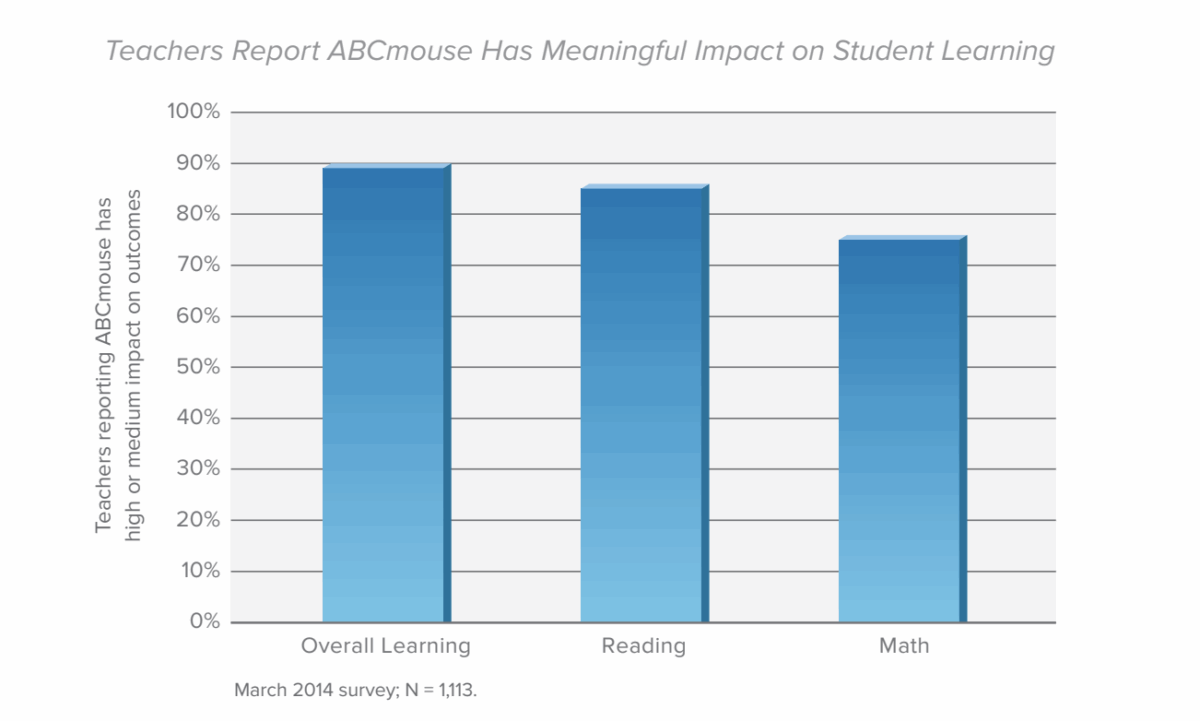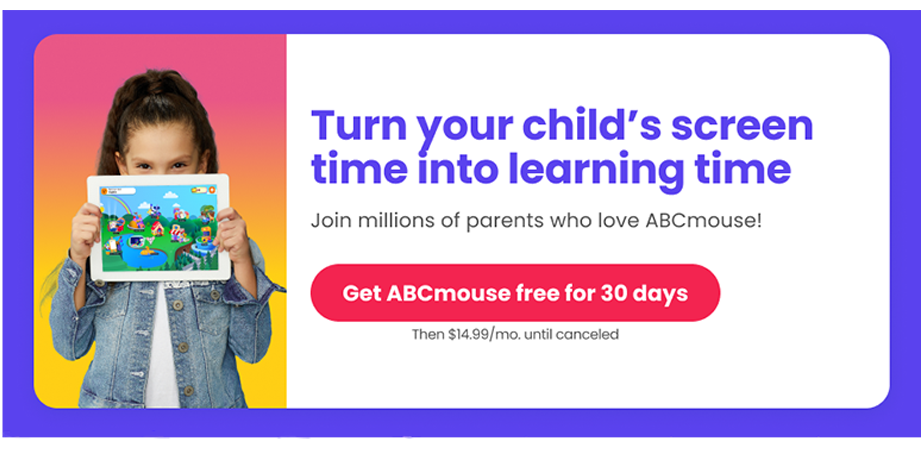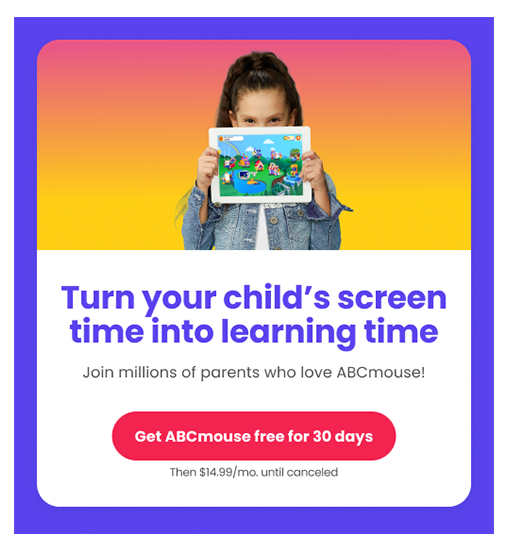
Harnessing Education Technology to Meet Diverse Learning Needs in the Classroom
Case study shows ABCmouse increases students’ foundational skills and confidence.
Table of Contents – Jump to Each Section
ABCmouse: Engaging Diverse Learners
ABCmouse: Differentiation by Student Level
“I implemented ABCmouse in every lesson . . . My students started picking up their letters faster. They were applying phonics faster. They were recognizing sight words faster. When testing came around, I had 78 percent of my class test advanced in foundational skills. That’s never happened before. But to me, ABCmouse is more than just high test scores, because the results that you will see in your students not only benefit them academically, but also give them self-confidence to love school, to love learning.”
—Laura Bryant, Las Cruces, New Mexico
ABCmouse Case Study Overview
Laura Bryant is a kindergarten teacher in a low-income community in New Mexico. Her students all qualify for the free breakfast program, and 90 percent qualify for free or reduced lunch. She knows they are at high risk for school failure when they first come into her classroom. However, Laura sees an opportunity to help them build the skills necessary for academic success. The challenge lies in meeting the diverse learning needs of her students, including a range of English Language Learning (ELL) needs. “I have students who already know [how to spell] their name and their letters, but then I have ones who don’t know their letters or their sounds.”
Research Insights:
Research has found that the earlier a student acquires English proficiency as a second language, the more likely it is that they will develop academically at a similar rate to their native English speaking peers. For example, a child who achieves English proficiency by kindergarten entry earns similar reading and math scores to native English speakers; however, a child who is not proficient until first grade experiences a gap in scores as compared to native speakers.1
Laura began using ABCmouse.com Early Learning Academy, a supplementary curriculum available online and as an app, during the 2012–13 school year. “ABCmouse is the one website I integrate into all my lessons on a daily basis,” she notes. Laura employed a three-pronged, differentiated teaching strategy to 1) engage students with fun and diverse learning activities; 2) provide individualized lessons for below-, at-, and above-grade-level students; and 3) vary the delivery and mode of instruction for students to learn individually, in small groups, and with the entire class. Additionally, she discovered that ABCmouse was a valuable ELL resource for the students in her class who primarily spoke Spanish.
ABCmouse: Engaging Diverse Learners
Regardless of how educational content is delivered, in order for children to acquire new information and skills, they must engage with the content being taught. Laura found that with ABCmouse she no longer struggled to gain and retain the attention of her students on academic subjects. They consistently asked to “play” on ABCmouse and were excited when Laura would let them choose areas of the program in which to spend time after they had completed their assigned lessons:
“ABCmouse captivates a child’s attention in such a wonderful, marvelous way. It’s not just them memorizing stuff. They have the concept; they have the skill, and they’re making those connections across the content areas. [With ABCmouse] we have literacy, we have numeracy, we have science, social studies; there’s even music and art. I can integrate it into my lessons, into the curriculum, and reinforce and review everything that’s being applied and learned in class. ABCmouse is one of those tools that can fit so easily into lessons and activities for both students and teachers.”
The wide range of ABCmouse learning activities provided each student with something to engage them in learning, based on their individual interests. Laura discovered thousands of activities to reinforce the important skills and concepts that she teaches, through books, games, puzzles, art, and music videos that appeal to different types of learners. As a result, she increased student engagement and focus, which led to important gains in academic skills:
“One hundred percent of my class made significant improvement beyond expectations after using ABCmouse. I’ve never seen a group of kids that are all reading, writing, adding, and subtracting by the end of kindergarten. They know what the sounds are. They know what their letters are. They know what their numbers are; they can count forwards and backwards all the way to 100.”
Laura’s experience with ABCmouse is not unique. In a survey of more than 1,000 teachers using ABCmouse in their classrooms, more than 90 percent reported that ABCmouse had a high or medium impact on their students’ learning.

ABCmouse: Differentiation by Student Level
Each year, Laura finds that she has students who need a highly individualized approach to learning. One such student was a boy who had witnessed domestic violence and was placed in foster care. This student had an Individualized Education Plan (IEP) to help him learn while coping with attention deficit hyperactivity disorder (ADHD) and behavioral challenges. He was introduced to ABCmouse with the rest of the class:
“He loved it! I was able to get a good 30 minutes of attention from him, with him working, staying on task, and focusing. He knew that if he listened, learned, and behaved for at least the first 10–15 minutes of the whole group lesson, that he would be able to use ABCmouse. At the end of the year, he was near proficiency and missed the benchmark for reading by only one or two words. He could sound and blend, and he could count. He had his one-to-one correspondence.”
Another struggling student in Laura’s classroom benefited from a highly individualized curriculum using ABCmouse; it helped her learn to speak and read English, which was not her first language:
“When school first started, I had a student who had no reading skills whatsoever. When I finished testing at the end of the year, not only did she know all her letters in order and out of order, but she was reading 169 words per minute. In order for her to go to first grade, she had to read a minimum of 25 words per minute with fluency.”
Research Insights:
Research confirms the value of differentiating instruction, particularly for those children who are at the highest risk for educational failure.2 Current school realities challenge teachers to provide quality instruction for all learners: students with special needs, students learning English, and students who are gifted. Changing demographics, an emphasis on inclusion, a reduction in gifted and talented programs, and an effort to reduce the segregation of struggling learners has changed the role of teachers in meeting the diverse needs in their classrooms with their own lesson planning.3
In addition to using ABCmouse as a supplementary resource for children below grade level, Laura found it had a positive impact on advanced students, too. She describes how one gifted child was able to use ABCmouse for more challenging reading while remaining in the classroom with his same-aged peers:
He would say, “I’m gonna go to the challenging part.” He would like to go to the folk and fairy tale section because he could practice his reading. My kids, once they take of on it, they figure out how to change and adjust things. The website is so kid-friendly and so user-friendly that all of them (doesn’t matter if they’re high or low) can figure out how to change the settings to where they can actually challenge themselves. In this case, he was reading at a second-grade level, and in the middle of the year he figured out how to turn of the speaker and the highlighting because he wanted to try and read it by himself.”
Within her classroom, Laura successfully met the needs of her most at-risk students and her most advanced students with the same educational resource. “When they’re on the low end, I can assign lessons and activities that will help them; if I have a higher student who already knows sounds and letters, I can assign a completely different lesson for a challenge.”
ABCmouse: Differentiation by Instruction Mode
Laura often used ABCmouse learning activities to demonstrate a concept or skill to her students during whole-class instruction. Then, as they worked in centers, students had the opportunity to reinforce those skills individually or in small groups through more ABCmouse activities:
“I do my whole group lesson for about 15 to 20 minutes. After that are centers where I can teach in small groups. One of those centers is always ABCmouse for 15- to 18-minute rotations. So they have 18 minutes in the morning, 18 minutes at lunchtime, and 18 minutes in the afternoon. Mondays, Wednesdays, and Thursdays they have assigned, specific activities to complete. On Fridays, they complete one activity and then can explore.”
Research Insights:
Researchers highlight the need for teachers to vary the mode of instruction as part of a differentiated approach and support the use of technology in that effort.4 A meta-analysis of 122 studies on the use of technology in differentiating modes of instruction concluded that small group learning had more positive effects on achievement than individual learning; however, both types are necessary to meet the needs of all students.5
Laura found that the diverse activities in ABCmouse enable an engaging and interactive experience that can be delivered to her students in various groupings to teach key concepts. For example, she introduced the letter “A” with a music video on ABCmouse to the entire class:
“On ABCmouse, I would click on the letter ‘A,’ and then the visual learners have an example of the ‘A.’ And some kids like to dance, so I let them dance to the music. Some of them use the hand movement that we learned in class for the ‘A’ sound.”
After the whole-group instruction, students sat at the computers during center time and reinforced their understanding by completing ABCmouse games, puzzles, books, and art related to the letter “A” and the sounds that it stands for. And for any student that needed additional assistance, Laura assigned specific activities at the student’s appropriate level to be completed individually in class or at home.
ABCmouse Case Study Summary
Laura found effective new ways to differentiate instruction by incorporating high-quality education technology into the everyday routines of her classroom. Her inclusion of ABCmouse supplemented her curriculum with diverse activities, targeted the individual needs of each student, and facilitated different modes of teaching. By taking differentiated instruction to the next level, Laura helped her students make strong academic gains, and it has become a valued learning resource in her classroom ever since:
“I am a strong believer in ABCmouse and have continued to use this curriculum in my class for four years now, and it’s not going away! During my structured teaching time, I always implement ABCmouse into my whole-group and small group instruction, and even as a free choice center. This year, our school offcially became a Dual Language Magnet public school, and ABCmouse has again proven to benefit not only my native English speakers, but my English Language Learners alike.”
Notes:
1. Director of Research and Educational Partnerships, Age of Learning, Inc.; formerly Assistant Professor and Director of Early Childhood Education Master’s Program, Loyola Marymount University Halle, Hair, Wandner, McNamara, & Chien (2012)
2. Darling-Hammond, Wise, & Klein (1999) 3 Sapon-Shevin (2001)
3. Sapon-Shevin (2001)
4. Stanford, Crowe, & Flice (2010) 5 Lou, Abrami, & d’Apollonia (2001)
5. Lou, Abrami, & d’Apollonia (2001)
References:
Darling-Hammond, L., Wise, A., & Klein, S. (1999). A license to teach: Raising standards for teaching. San Francisco: Jossey-Bass.
Halle, T., Hair, E., Wandner, L., McNamara, M., & Chien, N. (2012). Predictors and outcomes of early versus later English language proficiency among English language learners. Early Childhood Research Quarterly, 27(1), 1-20.
Lou, Y, Abrami, P. C., & d’Apollonia, S. (2001). Small group and individual learning with technology: A meta-analysis. Review
of Educational Research, 71(3), 449-521.
Sapon-Shevin, M. (2001). Schools fit for all. Educational Leadership, 58(4), 34-39.
Stanford, P., Crowe, M. W., & Flice, H. (2010). Differentiating with technology. Teaching Exceptional Children Plus, 6(4),
2-9.
TM & © 2016 Age of Learning, Inc. All rights reserved. The names of other companies, products, and services are the property of their respective owners.



